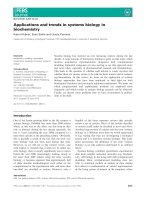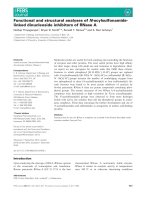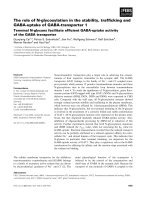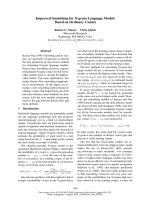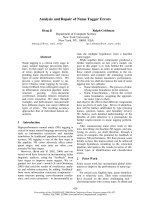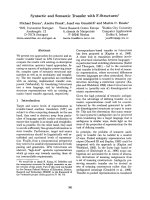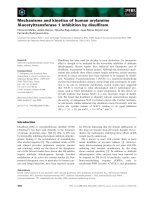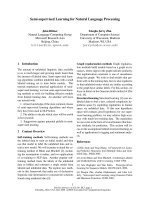Báo cáo khoa học: "Faster and Smaller N -Gram Language Models" pptx
Bạn đang xem bản rút gọn của tài liệu. Xem và tải ngay bản đầy đủ của tài liệu tại đây (273.57 KB, 10 trang )
Proceedings of the 49th Annual Meeting of the Association for Computational Linguistics, pages 258–267,
Portland, Oregon, June 19-24, 2011.
c
2011 Association for Computational Linguistics
Faster and Smaller N -Gram Language Models
Adam Pauls Dan Klein
Computer Science Division
University of California, Berkeley
{adpauls,klein}@cs.berkeley.edu
Abstract
N-gram language models are a major resource
bottleneck in machine translation. In this pa-
per, we present several language model imple-
mentations that are both highly compact and
fast to query. Our fastest implementation is
as fast as the widely used SRILM while re-
quiring only 25% of the storage. Our most
compact representation can store all 4 billion
n-grams and associated counts for the Google
n-gram corpus in 23 bits per n-gram, the most
compact lossless representation to date, and
even more compact than recent lossy compres-
sion techniques. We also discuss techniques
for improving query speed during decoding,
including a simple but novel language model
caching technique that improves the query
speed of our language models (and SRILM)
by up to 300%.
1 Introduction
For modern statistical machine translation systems,
language models must be both fast and compact.
The largest language models (LMs) can contain as
many as several hundred billion n-grams (Brants
et al., 2007), so storage is a challenge. At the
same time, decoding a single sentence can trig-
ger hundreds of thousands of queries to the lan-
guage model, so speed is also critical. As al-
ways, trade-offs exist between time, space, and ac-
curacy, with many recent papers considering small-
but-approximate noisy LMs (Chazelle et al., 2004;
Guthrie and Hepple, 2010) or small-but-slow com-
pressed LMs (Germann et al., 2009).
In this paper, we present several lossless meth-
ods for compactly but efficiently storing large LMs
in memory. As in much previous work (Whittaker
and Raj, 2001; Hsu and Glass, 2008), our meth-
ods are conceptually based on tabular trie encodings
wherein each n-gram key is stored as the concatena-
tion of one word (here, the last) and an offset encod-
ing the remaining words (here, the context). After
presenting a bit-conscious basic system that typifies
such approaches, we improve on it in several ways.
First, we show how the last word of each entry can
be implicitly encoded, almost entirely eliminating
its storage requirements. Second, we show that the
deltas between adjacent entries can be efficiently en-
coded with simple variable-length encodings. Third,
we investigate block-based schemes that minimize
the amount of compressed-stream scanning during
lookup.
To speed up our language models, we present two
approaches. The first is a front-end cache. Caching
itself is certainly not new to language modeling, but
because well-tuned LMs are essentially lookup ta-
bles to begin with, naive cache designs only speed
up slower systems. We present a direct-addressing
cache with a fast key identity check that speeds up
our systems (or existing fast systems like the widely-
used, speed-focused SRILM) by up to 300%.
Our second speed-up comes from a more funda-
mental change to the language modeling interface.
Where classic LMs take word tuples and produce
counts or probabilities, we propose an LM that takes
a word-and-context encoding (so the context need
not be re-looked up) and returns both the probabil-
ity and also the context encoding for the suffix of the
original query. This setup substantially accelerates
the scrolling queries issued by decoders, and also
exploits language model state equivalence (Li and
Khudanpur, 2008).
Overall, we are able to store the 4 billion n-grams
of the Google Web1T (Brants and Franz, 2006) cor-
258
pus, with associated counts, in 10 GB of memory,
which is smaller than state-of-the-art lossy language
model implementations (Guthrie and Hepple, 2010),
and significantly smaller than the best published
lossless implementation (Germann et al., 2009). We
are also able to simultaneously outperform SRILM
in both total size and speed. Our LM toolkit, which
is implemented in Java and compatible with the stan-
dard ARPA file formats, is available on the web.
1
2 Preliminaries
Our goal in this paper is to provide data structures
that map n-gram keys to values, i.e. probabilities
or counts. Maps are fundamental data structures
and generic implementations of mapping data struc-
tures are readily available. However, because of the
sheer number of keys and values needed for n-gram
language modeling, generic implementations do not
work efficiently “out of the box.” In this section,
we will review existing techniques for encoding the
keys and values of an n-gram language model, tak-
ing care to account for every bit of memory required
by each implementation.
To provide absolute numbers for the storage re-
quirements of different implementations, we will
use the Google Web1T corpus as a benchmark. This
corpus, which is on the large end of corpora typically
employed in language modeling, is a collection of
nearly 4 billion n-grams extracted from over a tril-
lion tokens of English text, and has a vocabulary of
about 13.5 million words.
2.1 Encoding Values
In the Web1T corpus, the most frequent n-gram
occurs about 95 billion times. Storing this count
explicitly would require 37 bits, but, as noted by
Guthrie and Hepple (2010), the corpus contains only
about 770 000 unique counts, so we can enumerate
all counts using only 20 bits, and separately store an
array called the value rank array which converts the
rank encoding of a count back to its raw count. The
additional array is small, requiring only about 3MB,
but we save 17 bits per n-gram, reducing value stor-
age from around 16GB to about 9GB for Web1T.
We can rank encode probabilities and back-offs in
the same way, allowing us to be agnostic to whether
1
/>we encode counts, probabilities and/or back-off
weights in our model. In general, the number of bits
per value required to encode all value ranks for a
given language model will vary – we will refer to
this variable as v .
2.2 Trie-Based Language Models
The data structure of choice for the majority of
modern language model implementations is a trie
(Fredkin, 1960). Tries or variants thereof are
implemented in many LM tool kits, including
SRILM (Stolcke, 2002), IRSTLM (Federico and
Cettolo, 2007), CMU SLM (Whittaker and Raj,
2001), and MIT LM (Hsu and Glass, 2008). Tries
represent collections of n-grams using a tree. Each
node in the tree encodes a word, and paths in the
tree correspond to n-grams in the collection. Tries
ensure that each n-gram prefix is represented only
once, and are very efficient when n-grams share
common prefixes. Values can also be stored in a trie
by placing them in the appropriate nodes.
Conceptually, trie nodes can be implemented as
records that contain two entries: one for the word
in the node, and one for either a pointer to the par-
ent of the node or a list of pointers to children. At
a low level, however, naive implementations of tries
can waste significant amounts of space. For exam-
ple, the implementation used in SRILM represents a
trie node as a C struct containing a 32-bit integer
representing the word, a 64-bit memory
2
pointer to
the list of children, and a 32-bit floating point num-
ber representing the value stored at a node. The total
storage for a node alone is 16 bytes, with additional
overhead required to store the list of children. In
total, the most compact implementation in SRILM
uses 33 bytes per n-gram of storage, which would
require around 116 GB of memory to store Web1T.
While it is simple to implement a trie node in this
(already wasteful) way in programming languages
that offer low-level access to memory allocation like
C/C++, the situation is even worse in higher level
programming languages. In Java, for example, C-
style structs are not available, and records are
most naturally implemented as objects that carry an
additional 64 bits of overhead.
2
While 32-bit architectures are still in use today, their lim-
ited address space is insufficient for modern language models
and we will assume all machines use a 64-bit architecture.
259
Despite its relatively large storage requirements,
the implementation employed by SRILM is still
widely in use today, largely because of its speed – to
our knowledge, SRILM is the fastest freely available
language model implementation. We will show that
we can achieve access speeds comparable to SRILM
but using only 25% of the storage.
2.3 Implicit Tries
A more compact implementation of a trie is de-
scribed in Whittaker and Raj (2001). In their imple-
mentation, nodes in a trie are represented implicitly
as entries in an array. Each entry encodes a word
with enough bits to index all words in the language
model (24 bits for Web1T), a quantized value, and
a 32-bit
3
offset that encodes the contiguous block
of the array containing the children of the node.
Note that 32 bits is sufficient to index all n-grams in
Web1T; for larger corpora, we can always increase
the size of the offset.
Effectively, this representation replaces system-
level memory pointers with offsets that act as logical
pointers that can reference other entries in the array,
rather than arbitrary bytes in RAM. This represen-
tation saves space because offsets require fewer bits
than memory pointers, but more importantly, it per-
mits straightforward implementation in any higher-
level language that provides access to arrays of inte-
gers.
4
2.4 Encoding n-grams
Hsu and Glass (2008) describe a variant of the im-
plicit tries of Whittaker and Raj (2001) in which
each node in the trie stores the prefix (i.e. parent).
This representation has the property that we can re-
fer to each n-gram w
n
1
by its last word w
n
and the
offset c(w
n−1
1
) of its prefix w
n−1
1
, often called the
context. At a low-level, we can efficiently encode
this pair (w
n
, c(w
n−1
1
)) as a single 64-bit integer,
where the first 24 bits refer to w
n
and the last 40 bits
3
The implementation described in the paper represents each
32-bit integer compactly using only 16 bits, but this represen-
tation is quite inefficient, because determining the full 32-bit
offset requires a binary search in a look up table.
4
Typically, programming languages only provide support
for arrays of bytes, not bits, but it is of course possible to simu-
late arrays with arbitrary numbers of bits using byte arrays and
bit manipulation.
encode c(w
n−1
1
). We will refer to this encoding as a
context encoding.
Note that typically, n-grams are encoded in tries
in the reverse direction (first-rest instead of last-
rest), which enables a more efficient computation of
back-offs. In our implementations, we found that the
speed improvement from switching to a first-rest en-
coding and implementing more efficient queries was
modest. However, as we will see in Section 4.2, the
last-rest encoding allows us to exploit the scrolling
nature of queries issued by decoders, which results
in speedups that far outweigh those achieved by re-
versing the trie.
3 Language Model Implementations
In the previous section, we reviewed well-known
techniques in language model implementation. In
this section, we combine these techniques to build
simple data structures in ways that are to our knowl-
edge novel, producing language models with state-
of-the-art memory requirements and speed. We will
also show that our data structures can be very effec-
tively compressed by implicitly encoding the word
w
n
, and further compressed by applying a variable-
length encoding on context deltas.
3.1 Sorted Array
A standard way to implement a map is to store an
array of key/value pairs, sorted according to the key.
Lookup is carried out by performing binary search
on a key. For an n-gram language model, we can ap-
ply this implementation with a slight modification:
we need n sorted arrays, one for each n-gram order.
We construct keys (w
n
, c(w
n−1
1
)) using the context
encoding described in the previous section, where
the context offsets c refer to entries in the sorted ar-
ray of (n − 1)-grams. This data structure is shown
graphically in Figure 1.
Because our keys are sorted according to their
context-encoded representation, we cannot straight-
forwardly answer queries about an n-gram w with-
out first determining its context encoding. We can
do this efficiently by building up the encoding in-
crementally: we start with the context offset of the
unigram w
1
, which is simply its integer representa-
tion, and use that to form the context encoding of the
bigram w
2
1
= (w
2
, c(w
1
)). We can find the offset of
260
“ran”
w c
15180053
w c
24
bits
40
bits
64 bits
“cat”
15176585
“dog”
6879
6879
6879
6879
6879
6880
6880
6880
6879
00004598
“slept”
00004588
00004568
00004530
00004502
00004668
00004669
00004568
00004577
6879 0000449815176583
15176585
15176593
15176613
15179801
15180051
15176589
15176591
“had”
“the”
“left”
1933
.
.
.
.
.
.
.
.
.
.
.
.
“slept”
1933
1933
1933
1933
1933
1933
1935
1935
1935
.
.
val
val
val
v
bits
.
.
“dog”
3-grams
2-grams 1-grams
w
Figure 1: Our SORTED implementation of a trie. The dotted paths correspond to “the cat slept”, “the cat ran”, and “the
dog ran”. Each node in the trie is an entry in an array with 3 parts: w represents the word at the node; val represents
the (rank encoded) value; and c is an offset in the array of n − 1 grams that represents the parent (prefix) of a node.
Words are represented as offsets in the unigram array.
the bigram using binary search, and form the context
encoding of the trigram, and so on. Note, however,
that if our queries arrive in context-encoded form,
queries are faster since they involve only one binary
search in the appropriate array. We will return to this
later in Section 4.2
This implementation, SORTED, uses 64 bits for
the integer-encoded keys and v bits for the values.
Lookup is linear in the length of the key and log-
arithmic in the number of n-grams. For Web1T
(v = 20), the total storage is 10.5 bytes/n-gram or
about 37GB.
3.2 Hash Table
Hash tables are another standard way to implement
associative arrays. To enable the use of our context
encoding, we require an implementation in which
we can refer to entries in the hash table via array
offsets. For this reason, we use an open address hash
map that uses linear probing for collision resolution.
As in the sorted array implementation, in order to
insert an n-gram w
n
1
into the hash table, we must
form its context encoding incrementally from the
offset of w
1
. However, unlike the sorted array im-
plementation, at query time, we only need to be
able to check equality between the query key w
n
1
=
(w
n
, c(w
n−1
1
)) and a key w
n
1
= (w
n
, c(w
n−1
1
)) in
the table. Equality can easily be checked by first
checking if w
n
= w
n
, then recursively checking
equality between w
n−1
1
and w
n−1
1
, though again,
equality is even faster if the query is already context-
encoded.
This HASH data structure also uses 64 bits for
integer-encoded keys and v bits for values. How-
ever, to avoid excessive hash collisions, we also al-
locate additional empty space according to a user-
defined parameter that trades off speed and time –
we used about 40% extra space in our experiments.
For Web1T, the total storage for this implementation
is 15 bytes/n-gram or about 53 GB total.
Look up in a hash map is linear in the length of
an n-gram and constant with respect to the number
261
of n-grams. Unlike the sorted array implementa-
tion, the hash table implementation also permits ef-
ficient insertion and deletion, making it suitable for
stream-based language models (Levenberg and Os-
borne, 2009).
3.3 Implicitly Encoding w
n
The context encoding we have used thus far still
wastes space. This is perhaps most evident in the
sorted array representation (see Figure 1): all n-
grams ending with a particular word w
i
are stored
contiguously. We can exploit this redundancy by
storing only the context offsets in the main array,
using as many bits as needed to encode all context
offsets (32 bits for Web1T). In auxiliary arrays, one
for each n-gram order, we store the beginning and
end of the range of the trie array in which all (w
i
, c)
keys are stored for each w
i
. These auxiliary arrays
are negligibly small – we only need to store 2n off-
sets for each word.
The same trick can be applied in the hash table
implementation. We allocate contiguous blocks of
the main array for n-grams which all share the same
last word w
i
, and distribute keys within those ranges
using the hashing function.
This representation reduces memory usage for
keys from 64 bits to 32 bits, reducing overall storage
for Web1T to 6.5 bytes/n-gram for the sorted imple-
mentation and 9.1 bytes for the hashed implementa-
tion, or about 23GB and 32GB in total. It also in-
creases query speed in the sorted array case, since to
find (w
i
, c), we only need to search the range of the
array over which w
i
applies. Because this implicit
encoding reduces memory usage without a perfor-
mance cost, we will assume its use for the rest of
this paper.
3.4 A Compressed Implementation
3.4.1 Variable-Length Coding
The distribution of value ranks in language mod-
eling is Zipfian, with far more n-grams having low
counts than high counts. If we ensure that the value
rank array sorts raw values by descending order of
frequency, then we expect that small ranks will oc-
cur much more frequently than large ones, which we
can exploit with a variable-length encoding.
To compress n-grams, we can exploit the context
encoding of our keys. In Figure 2, we show a portion
w
c
val
1933
15176585
3
1933
15176587
2
1933
15176593
1
1933
15176613
8
1933
15179801
1
1935
15176585
298
1935
15176589
1
1933
15176585
563097887
956
3
0
+0
+2
2
+0
+5
1
+0
+40
8
!w
!c
val
1933
15176585
3
+0
+2
1
+0
+5
1
+0
+40
8
+0
+188
1
+2
15176585
298
+0
+4
1
|!w|
|!c|
|val|
24
40
3
2
3
3
2
3
3
2
9
6
2
12
3
4
36
15
2
6
3
. . .
(a) Context-Encoding (b) Context Deltas (c) Bits Required
(d) Compressed Array
Number
of bits
in this
block
Value rank
for header
key
Header
key
Logical
offset of
this block
True if
all !w in
block are
0
Figure 2: Compression using variable-length encoding.
(a) A snippet of an (uncompressed) context-encoded ar-
ray. (b) The context and word deltas. (c) The number
of bits required to encode the context and word deltas as
well as the value ranks. Word deltas use variable-length
block coding with k = 1, while context deltas and value
ranks use k = 2. (d) A snippet of the compressed encod-
ing array. The header is outlined in bold.
of the key array used in our sorted array implemen-
tation. While we have already exploited the fact that
the 24 word bits repeat in the previous section, we
note here that consecutive context offsets tend to be
quite close together. We found that for 5-grams, the
median difference between consecutive offsets was
about 50, and 90% of offset deltas were smaller than
10000. By using a variable-length encoding to rep-
resent these deltas, we should require far fewer than
32 bits to encode context offsets.
We used a very simple variable-length coding to
encode offset deltas, word deltas, and value ranks.
Our encoding, which is referred to as “variable-
length block coding” in Boldi and Vigna (2005),
works as follows: we pick a (configurable) radix
r = 2
k
. To encode a number m, we determine the
number of digits d required to express m in base r.
We write d in unary, i.e. d − 1 zeroes followed by
a one. We then write the d digits of m in base r,
each of which requires k bits. For example, using
k = 2, we would encode the decimal number 7 as
010111. We can choose k separately for deltas and
value indices, and also tune these parameters to a
given language model.
We found this encoding outperformed other
standard prefix codes, including Golomb
codes (Golomb, 1966; Church et al., 2007)
262
and Elias γ and δ codes. We also experimented
with the ζ codes of Boldi and Vigna (2005), which
modify variable-length block codes so that they
are optimal for certain power law distributions.
We found that ζ codes performed no better than
variable-length block codes and were slightly more
complex. Finally, we found that Huffman codes
outperformed our encoding slightly, but came at a
much higher computational cost.
3.4.2 Block Compression
We could in principle compress the entire array of
key/value pairs with the encoding described above,
but this would render binary search in the array im-
possible: we cannot jump to the mid-point of the ar-
ray since in order to determine what key lies at a par-
ticular point in the compressed bit stream, we would
need to know the entire history of offset deltas.
Instead, we employ block compression, a tech-
nique also used by Harb et al. (2009) for smaller
language models. In particular, we compress the
key/value array in blocks of 128 bytes. At the be-
ginning of the block, we write out a header consist-
ing of: an explicit 64-bit key that begins the block;
a 32-bit integer representing the offset of the header
key in the uncompressed array;
5
the number of bits
of compressed data in the block; and the variable-
length encoding of the value rank of the header key.
The remainder of the block is filled with as many
compressed key/value pairs as possible. Once the
block is full, we start a new block. See Figure 2 for
a depiction.
When we encode an offset delta, we store the delta
of the word portion of the key separately from the
delta of the context offset. When an entire block
shares the same word portion of the key, we set a
single bit in the header that indicates that we do not
encode any word deltas.
To find a key in this compressed array, we first
perform binary search over the header blocks (which
are predictably located every 128 bytes), followed
by a linear search within a compressed block.
Using k = 6 for encoding offset deltas and k = 5
for encoding value ranks, this COMPRESSED im-
plementation stores Web1T in less than 3 bytes per
n-gram, or about 10.2GB in total. This is about
5
We need this because n-grams refer to their contexts using
array offsets.
6GB less than the storage required by Germann et
al. (2009), which is the best published lossless com-
pression to date.
4 Speeding up Decoding
In the previous section, we provided compact and
efficient implementations of associative arrays that
allow us to query a value for an arbitrary n-gram.
However, decoders do not issue language model re-
quests at random. In this section, we show that lan-
guage model requests issued by a standard decoder
exhibit two patterns we can exploit: they are highly
repetitive, and also exhibit a scrolling effect.
4.1 Exploiting Repetitive Queries
In a simple experiment, we recorded all of the
language model queries issued by the Joshua de-
coder (Li et al., 2009) on a 100 sentence test set.
Of the 31 million queries, only about 1 million were
unique. Therefore, we expect that keeping the re-
sults of language model queries in a cache should be
effective at reducing overall language model latency.
To this end, we added a very simple cache to
our language model. Our cache uses an array of
key/value pairs with size fixed to 2
b
− 1 for some
integer b (we used 24). We use a b-bit hash func-
tion to compute the address in an array where we
will always place a given n-gram and its fully com-
puted language model score. Querying the cache is
straightforward: we check the address of a key given
by its b-bit hash. If the key located in the cache ar-
ray matches the query key, then we return the value
stored in the cache. Otherwise, we fetch the lan-
guage model probability from the language model
and place the new key and value in the cache, evict-
ing the old key in the process. This scheme is often
called a direct-mapped cache because each key has
exactly one possible address.
Caching n-grams in this way reduces overall la-
tency for two reasons: first, lookup in the cache is
extremely fast, requiring only a single evaluation of
the hash function, one memory lookup to find the
cache key, and one equality check on the key. In
contrast, even our fastest (HASH) implementation
may have to perform multiple memory lookups and
equality checks in order to resolve collisions. Sec-
ond, when calculating the probability for an n-gram
263
the cat + fell down
the cat fell
cat fell down
18569876 fell
35764106 down
LM
0.76
LM
0.12
LM
LM
0.76
0.12
“the cat”
“cat fell”
3576410
Explicit
Representation
Context
Encoding
Figure 3: Queries issued when scoring trigrams that are
created when a state with LM context “the cat” combines
with “fell down”. In the standard explicit representation
of an n-gram as list of words, queries are issued atom-
ically to the language model. When using a context-
encoding, a query from the n-gram “the cat fell” returns
the context offset of “cat fell”, which speeds up the query
of “cat fell down”.
not in the language model, language models with
back-off schemes must in general perform multiple
queries to fetch the necessary back-off information.
Our cache retains the full result of these calculations
and thus saves additional computation.
Federico and Cettolo (2007) also employ a cache
in their language model implementation, though
based on traditional hash table cache with linear
probing. Unlike our cache, which is of fixed size,
their cache must be cleared after decoding a sen-
tence. We would not expect a large performance in-
crease from such a cache for our faster models since
our HASH implementation is already a hash table
with linear probing. We found in our experiments
that a cache using linear probing provided marginal
performance increases of about 40%, largely be-
cause of cached back-off computation, while our
simpler cache increases performance by about 300%
even over our HASH LM implementation. More tim-
ing results are presented in Section 5.
4.2 Exploiting Scrolling Queries
Decoders with integrated language models (Och and
Ney, 2004; Chiang, 2005) score partial translation
hypotheses in an incremental way. Each partial hy-
pothesis maintains a language model context con-
sisting of at most n − 1 target-side words. When
we combine two language model contexts, we create
several new n-grams of length of n, each of which
generate a query to the language model. These new
WMT2010
Order #n-grams
1gm 4,366,395
2gm 61,865,588
3gm 123,158,761
4gm 217,869,981
5gm 269,614,330
Total 676,875,055
WEB1T
Order #n-grams
1gm 13,588,391
2gm 314,843,401
3gm 977,069,902
4gm 1,313,818,354
5gm 1,176,470,663
Total 3,795,790,711
Table 1: Sizes of the two language models used in our
experiments.
n-grams exhibit a scrolling effect, shown in Fig-
ure 3: the n − 1 suffix words of one n-gram form
the n − 1 prefix words of the next.
As discussed in Section 3, our LM implementa-
tions can answer queries about context-encoded n-
grams faster than explicitly encoded n-grams. With
this in mind, we augment the values stored in our
language model so that for a key (w
n
, c(w
n−1
1
)),
we store the offset of the suffix c(w
n
2
) as well as
the normal counts/probabilities. Then, rather than
represent the LM context in the decoder as an ex-
plicit list of words, we can simply store context off-
sets. When we query the language model, we get
back both a language model score and context offset
c( ˆw
n−1
1
), where ˆw
n−1
1
is the the longest suffix of
w
n−1
1
contained in the language model. We can then
quickly form the context encoding of the next query
by simply concatenating the new word with the off-
set c( ˆw
n−1
1
) returned from the previous query.
In addition to speeding up language model
queries, this approach also automatically supports an
equivalence of LM states (Li and Khudanpur, 2008):
in standard back-off schemes, whenever we compute
the probability for an n-gram (w
n
, c(w
n−1
1
)) when
w
n−1
1
is not in the language model, the result will be
the same as the result of the query (w
n
, c( ˆw
n−1
1
). It
is therefore only necessary to store as much of the
context as the language model contains instead of
all n − 1 words in the context. If a decoder main-
tains LM states using the context offsets returned
by our language model, then the decoder will au-
tomatically exploit this equivalence and the size of
the search space will be reduced. This same effect is
exploited explicitly by some decoders (Li and Khu-
danpur, 2008).
264
WMT2010
LM Type bytes/ bytes/ bytes/ Total
key value n-gram Size
SRILM-H – – 42.2 26.6G
SRILM-S – – 33.5 21.1G
HASH 5.6 6.0 11.6 7.5G
SORTED 4.0 4.5 8.5 5.5G
TPT – – 7.5
∗∗
4.7G
∗∗
COMPRESSED 2.1 3.8 5.9 3.7G
Table 2: Memory usages of several language model im-
plementations on the WMT2010 language model. A
∗∗
indicates that the storage in bytes per n-gram is re-
ported for a different language model of comparable size,
and the total size is thus a rough projection.
5 Experiments
5.1 Data
To test our LM implementations, we performed
experiments with two different language models.
Our first language model, WMT2010, was a 5-
gram Kneser-Ney language model which stores
probability/back-off pairs as values. We trained this
language model on the English side of all French-
English corpora provided
6
for use in the WMT 2010
workshop, about 2 billion tokens in total. This data
was tokenized using the tokenizer.perl script
provided with the data. We trained the language
model using SRILM. We also extracted a count-
based language model, WEB1T, from the Web1T
corpus (Brants and Franz, 2006). Since this data is
provided as a collection of 1- to 5-grams and asso-
ciated counts, we used this data without further pre-
processing. The make up of these language models
is shown in Table 1.
5.2 Compression Experiments
We tested our three implementations (HASH,
SORTED, and COMPRESSED) on the WMT2010
language model. For this language model, there are
about 80 million unique probability/back-off pairs,
so v ≈ 36. Note that here v includes both the
cost per key of storing the value rank as well as the
(amortized) cost of storing two 32 bit floating point
numbers (probability and back-off) for each unique
value. The results are shown in Table 2.
6
www.statmt.org/wmt10/translation-task.html
WEB1T
LM Type bytes/ bytes/ bytes/ Total
key value n-gram Size
Gzip – – 7.0 24.7G
T-MPHR
†
– – 3.0 10.5G
COMPRESSED 1.3 1.6 2.9 10.2G
Table 3: Memory usages of several language model im-
plementations on the WEB1T. A
†
indicates lossy com-
pression.
We compare against three baselines. The first two,
SRILM-H and SRILM-S, refer to the hash table-
and sorted array-based trie implementations pro-
vided by SRILM. The third baseline is the Tightly-
Packed Trie (TPT) implementation of Germann et
al. (2009). Because this implementation is not freely
available, we use their published memory usage in
bytes per n-gram on a language model of similar
size and project total usage.
The memory usage of all of our models is con-
siderably smaller than SRILM – our HASH imple-
mentation is about 25% the size of SRILM-H, and
our SORTED implementation is about 25% the size
of SRILM-S. Our COMPRESSED implementation
is also smaller than the state-of-the-art compressed
TPT implementation.
In Table 3, we show the results of our COM-
PRESSED implementation on WEB1T and against
two baselines. The first is compression of the ASCII
text count files using gzip, and the second is the
Tiered Minimal Perfect Hash (T-MPHR) of Guthrie
and Hepple (2010). The latter is a lossy compres-
sion technique based on Bloomier filters (Chazelle
et al., 2004) and additional variable-length encod-
ing that achieves the best published compression of
WEB1T to date. Our COMPRESSED implementa-
tion is even smaller than T-MPHR, despite using a
lossless compression technique. Note that since T-
MPHR uses a lossy encoding, it is possible to re-
duce the storage requirements arbitrarily at the cost
of additional errors in the model. We quote here the
storage required when keys
7
are encoded using 12-
bit hash codes, which gives a false positive rate of
about 2
−12
=0.02%.
7
Guthrie and Hepple (2010) also report additional savings
by quantizing values, though we could perform the same quan-
tization in our storage scheme.
265
LM Type No Cache Cache Size
COMPRESSED 9264±73ns 565±7ns 3.7G
SORTED 1405±50ns 243±4ns 5.5G
HASH 495±10ns 179±6ns 7.5G
SRILM-H 428±5ns 159±4ns 26.6G
HASH+SCROLL 323±5ns 139±6ns 10.5G
Table 4: Raw query speeds of various language model
implementations. Times were averaged over 3 runs on
the same machine. For HASH+SCROLL, all queries were
issued to the decoder in context-encoded form, which
speeds up queries that exhibit scrolling behaviour. Note
that memory usage is higher than for HASH because we
store suffix offsets along with the values for an n-gram.
LM Type No Cache Cache Size
COMPRESSED 9880±82s 1547±7s 3.7G
SRILM-H 1120±26s 938±11s 26.6G
HASH 1146±8s 943±16s 7.5G
Table 5: Full decoding times for various language model
implementations. Our HASH LM is as fast as SRILM
while using 25% of the memory. Our caching also re-
duces total decoding time by about 20% for our fastest
models and speeds up COMPRESSED by a factor of 6.
Times were averaged over 3 runs on the same machine.
5.3 Timing Experiments
We first measured pure query speed by logging all
LM queries issued by a decoder and measuring
the time required to query those n-grams in isola-
tion. We used the the Joshua decoder
8
with the
WMT2010 model to generate queries for the first
100 sentences of the French 2008 News test set. This
produced about 30 million queries. We measured the
time
9
required to perform each query in order with
and without our direct-mapped caching, not includ-
ing any time spent on file I/O.
The results are shown in Table 4. As expected,
HASH is the fastest of our implementations, and
comparable
10
in speed to SRILM-H, but using sig-
8
We used a grammar trained on all French-English data
provided for WMT 2010 using the make scripts provided
at />/joshua/1.3/wmt2010-experiment.tgz/download
9
All experiments were performed on an Amazon EC2 High-
Memory Quadruple Extra Large instance, with an Intel Xeon
X5550 CPU running at 2.67GHz and 8 MB of cache.
10
Because we implemented our LMs in Java, we issued
queries to SRILM via Java Native Interface (JNI) calls, which
introduces a performance overhead. When called natively, we
found that SRILM was about 200 ns/query faster. Unfortu-
nificantly less space. SORTED is slower but of
course more memory efficient, and COMPRESSED
is the slowest but also the most compact repre-
sentation. In HASH+SCROLL, we issued queries
to the language model using the context encoding,
which speeds up queries substantially. Finally, we
note that our direct-mapped cache is very effective.
The query speed of all models is boosted substan-
tially. In particular, our COMPRESSED implementa-
tion with caching is nearly as fast as SRILM-H with-
out caching, and even the already fast HASH imple-
mentation is 300% faster in raw query speed with
caching enabled.
We also measured the effect of LM performance
on overall decoder performance. We modified
Joshua to optionally use our LM implementations
during decoding, and measured the time required
to decode all 2051 sentences of the 2008 News
test set. The results are shown in Table 5. With-
out caching, SRILM-H and HASH were comparable
in speed, while COMPRESSED introduces a perfor-
mance penalty. With caching enabled, overall de-
coder speed is improved for both HASH and SRILM-
H, while the COMPRESSED implementation is only
about 50% slower that the others.
6 Conclusion
We have presented several language model imple-
mentations which are state-of-the-art in both size
and speed. Our experiments have demonstrated im-
provements in query speed over SRILM and com-
pression rates against state-of-the-art lossy compres-
sion. We have also described a simple caching tech-
nique which leads to performance increases in over-
all decoding time.
Acknowledgements
This work was supported by a Google Fellowship for the
first author and by BBN under DARPA contract HR0011-
06-C-0022. We would like to thank David Chiang, Zhifei
Li, and the anonymous reviewers for their helpful com-
ments.
nately, it is not completely fair to compare our LMs against ei-
ther of these numbers: although the JNI overhead slows down
SRILM, implementing our LMs in Java instead of C++ slows
down our LMs. In the tables, we quote times which include
the JNI overhead, since this reflects the true cost to a decoder
written in Java (e.g. Joshua).
266
References
Paolo Boldi and Sebastiano Vigna. 2005. Codes for the
world wide web. Internet Mathematics, 2.
Thorsten Brants and Alex Franz. 2006. Google web1t
5-gram corpus, version 1. In Linguistic Data Consor-
tium, Philadelphia, Catalog Number LDC2006T13.
Thorsten Brants, Ashok C. Popat, Peng Xu, Franz J. Och,
and Jeffrey Dean. 2007. Large language models in
machine translation. In Proceedings of the Conference
on Empirical Methods in Natural Language Process-
ing.
Bernard Chazelle, Joe Kilian, Ronitt Rubinfeld, and
Ayellet Tal. 2004. The Bloomier filter: an efficient
data structure for static support lookup tables. In Pro-
ceedings of the fifteenth annual ACM-SIAM sympo-
sium on Discrete algorithms.
David Chiang. 2005. A hierarchical phrase-based model
for statistical machine translation. In The Annual Con-
ference of the Association for Computational Linguis-
tics.
Kenneth Church, Ted Hart, and Jianfeng Gao. 2007.
Compressing trigram language models with golomb
coding. In Proceedings of the Conference on Empiri-
cal Methods in Natural Language Processing.
Marcello Federico and Mauro Cettolo. 2007. Efficient
handling of n-gram language models for statistical ma-
chine translation. In Proceedings of the Second Work-
shop on Statistical Machine Translation.
Edward Fredkin. 1960. Trie memory. Communications
of the ACM, 3:490–499, September.
Ulrich Germann, Eric Joanis, and Samuel Larkin. 2009.
Tightly packed tries: how to fit large models into mem-
ory, and make them load fast, too. In Proceedings of
the Workshop on Software Engineering, Testing, and
Quality Assurance for Natural Language Processing.
S. W. Golomb. 1966. Run-length encodings. IEEE
Transactions on Information Theory, 12.
David Guthrie and Mark Hepple. 2010. Storing the web
in memory: space efficient language models with con-
stant time retrieval. In Proceedings of the Conference
on Empirical Methods in Natural Language Process-
ing.
Boulos Harb, Ciprian Chelba, Jeffrey Dean, and Sanjay
Ghemawat. 2009. Back-off language model compres-
sion. In Proceedings of Interspeech.
Bo-June Hsu and James Glass. 2008. Iterative language
model estimation: Efficient data structure and algo-
rithms. In Proceedings of Interspeech.
Abby Levenberg and Miles Osborne. 2009. Stream-
based randomised language models for smt. In Pro-
ceedings of the Conference on Empirical Methods in
Natural Language Processing.
Zhifei Li and Sanjeev Khudanpur. 2008. A scalable
decoder for parsing-based machine translation with
equivalent language model state maintenance. In Pro-
ceedings of the Second Workshop on Syntax and Struc-
ture in Statistical Translation.
Zhifei Li, Chris Callison-Burch, Chris Dyer, Juri Gan-
itkevitch, Sanjeev Khudanpur, Lane Schwartz, Wren
N. G. Thornton, Jonathan Weese, and Omar F. Zaidan.
2009. Joshua: an open source toolkit for parsing-
based machine translation. In Proceedings of the
Fourth Workshop on Statistical Machine Translation.
Franz Josef Och and Hermann Ney. 2004. The align-
ment template approach to statistical machine transla-
tion. Computationl Linguistics, 30:417–449, Decem-
ber.
Andreas Stolcke. 2002. SRILM: An extensible language
modeling toolkit. In Proceedings of Interspeech.
E. W. D. Whittaker and B. Raj. 2001. Quantization-
based language model compression. In Proceedings
of Eurospeech.
267
